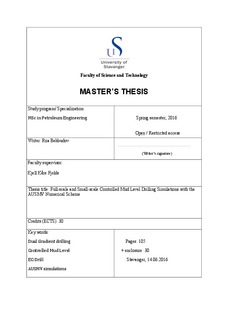| dc.description.abstract | Due to an increased demand from operator companies for deep-water drilling solutions, an interest in Dual Gradient technologies has risen. An example of such a technology is Controlled Mud Level (CML) drilling, where a subsea pump integrated in one of the riser joints actively controls the riser level. Reducing the hydrostatic component of the system helps to control pressures down-hole very accurately and fast. For this type of pressure control, an understanding of down-hole parameters as well as precise pressure estimate is required. This can be done by different numerical schemes. The scheme used in this thesis is AUSMV numerical scheme used mostly for academic purposes. In this work, a coupling between this scheme and CML technology mentioned before has been introduced.
This thesis has undertaken a literature survey from which it was concluded that CML is a promising technology, which finds compromises between several drilling aspects and makes operations more simple and less time consuming. A detailed review of the historical, technical and operational aspects of the technology was performed. Already existing commercial field applications confirms the future interest in CML. One of the breaking innovations with CML is early kick detection, which allows determining the reservoir influx in less than a minute. Well Control procedures used for the CML are close to Driller’s method. This is an advantage taking into consideration the time used for the training of the personnel.
After the technology has been reviewed in detail, simulations in Matlab have been performed to examine the ability of the AUSMV scheme to handle this type of well operations. Special focus was placed on the numerical boundary treatment on top of the well. Several ways of defining the outlet pressure boundary were investigated. In the end, setting the outlet pressure flux equal to 1 atm was concluded to be the best alternative. The scheme was available in two versions, 1st order and 2nd order. The updated 2nd order scheme differs from the original 1st order scheme by using slope limiters. This reduces numerical diffusion, which is a common problem with numerical schemes. After a comparison of the two schemes, the 2nd order showed more realistic and smoother results. The simulations of the 1st order scheme confirmed the problem of negative velocity fields for static conditions. Moreover, the problem with an outlet pressure representation at the beginning of simulations was discovered, which needs further investigation.
Next objective for this thesis was to adapt the scheme for the small-scale experimental flow-loop located at University of Stavanger (UIS). Two methods for achieving stable numerical solutions were found. Since the pressures delivered by the approximated small-scale model were very low, the first method involved pressurizing the system with 10 bars. This was a remedy introduced due to the problems the model had with handling the low pressures encountered in this simulation set-up. This was not optimal since it would not be possible to pressurize the system experimentally. However, an alternative method was found by editing a specific pressure condition in the code, which was there initially to assure stability but in this set-up was causing a problem. Both methods were compared and the alternative method was concluded to be the best out of the two. Nevertheless, it is important to test the experimental set-up with the proposed method first to be able to assess its efficiency. The simulation results found that the model is extremely friction dominated, a very important conclusion in this case. This might cause problems in studying this particular simulation case as it mostly relies on pressure control based on manipulations of the hydrostatic pressure component. Furthermore, the results showed that the effect of these manipulations was almost entirely masked by friction. A possible solution for this problem would be to move the suction point higher up in the well, which would reduce the height of the fluid column above. This fluid column was found to be the main contributor to the negative friction effect. | nb_NO |

